#kalligrammatid
Explore tagged Tumblr posts
Text
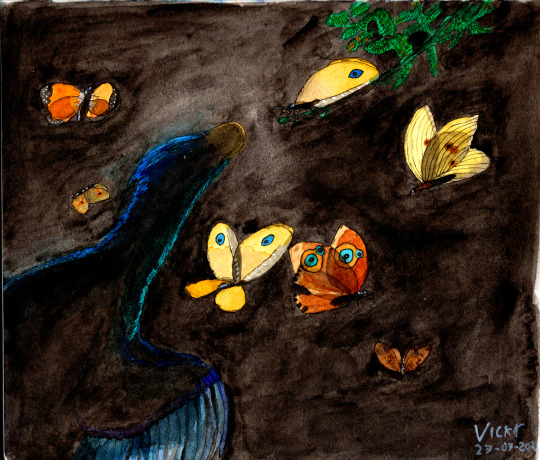
In a dense Sequoia forest where the darkness is broken by only a single solarbeam, a Caihong curiously inspects a Kalligrammatid, seeing a face not unlike its own staring back from the strange insect's transparent wings.
A bit of an experimental piece. Although kalligrammatids superficially look like butterflies, these Jurassic insects are in fact lacewings, entirely unrelated to butterflies! One of the differences this implies is that their gorgeously patterned wings were in fact transparent. This gave me the idea to use some extreme backlighting to really show them off, as well as the gloriously iridescent Caihong's feathers. This watercolour, for which I gratefully used this fantastic guide to restoring Kalligrammatids, features Affinigramma myrioneura; Kallihemerobius almacellus, aciedentatus, and feroculus; Kalligramma circularia, and the Maniraptoran-mimic Kalligramma brachyrhyncha.
#caihong#anchiornithid#kalligrammatid#neuroptera#avialan#bird#theropod#dinosaur#insect#cw: bugs#backlighting#watercolour#dark#jurassic#paleoart#my art#palaeoblr
148 notes
·
View notes
Text

Day 25 brings of MaySozoic my most ambitious piece yet...
The Kalligrammatid, extinct for 15 million years by then, but here. Nothing says eldritch like the itch you get from an insect's bite.

#artwork#digital art#art#mouserrouser#monster#dinosaur#bones#paleontology#paleoart#cretaceous period#dino#monster art#maysozoic#pterosaur#azhdarchid#fantasy#creature art#hadrosaur#butterfly#kalligrammatid#prehistoric animals#prehistoric butterfly#insect#magic?#eldritch#eldritch horror#comic art#original comic
10 notes
·
View notes
Text


Maysozoic: Day 24-27
To make up for the days I missed
#paleoart#prehistory#maysozoic#xenoceratops#kalligrammatid#albertadromeus#dyoplosaurus#made with krita
4 notes
·
View notes
Text
love letter to kalligrammatid lacewings.....i miss u

27 notes
·
View notes
Note
top five carboniferous period animals (marine invertebrate bonus points)
First of all I was very disappointed to remember that kalligrammatids are from the Mesozoic rather than the Carboniferous and so I wouldn't be able to talk about the lacewings that tried so hard to be butterflies. Nevertheless:
1. Arthropleura

[ID: A museum model of an armored millipede several meters long, with grown people nearby for scale. End ID.]
A pedestrian choice? Perhaps. But I cannot deny my desire to sit on the back of one of these things and be carried very slowly through the forest like a child on one of those tiny trains they have in big malls.
2. Megarachne

[ID: An artistic interpretation of a eurypterid, an arthropod with four spindly legs and dot-like eyes. End ID.]
I like that some of the eurypterids during this period decided to branch off from looking at sea scorpions and decided to look like sea spiders instead.
3. Archaeothyris

[ID: A detailed, green-toned drawing of a creature that looks absurdly similar to a lizard but isn't. End ID.]
Oldest known synapsid. I appreciate the members of the mammal lineage who look indistinguishable from lizards. Good prelude to my beloved Permian.
4. Symmorium

[ID: A drawing of a dull purplish shark with large eyes and a wide mouth that appears to be grinning. End ID.]
"hehehehe"
5. Akmonistion

[ID: An illustration of a shark with bristles on its head and on its flat-topped dorsal fin. End ID.]
Tbh I just feel bad for it.
126 notes
·
View notes
Photo
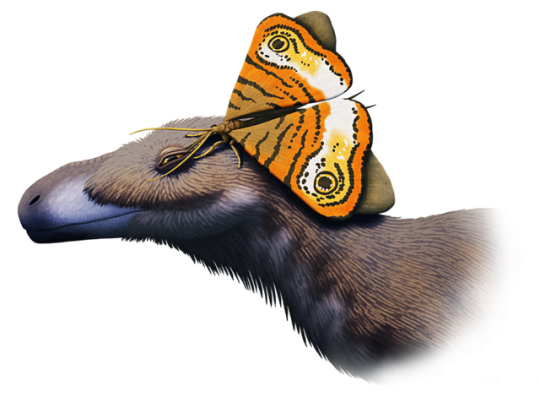
Did you know butterflies weren’t the first insects to look like butterflies?
Lepidopterans (the group of insects containing moths and butterflies) have been around since the Late Triassic -- but it wasn’t until the diversification of flowering plants during the Cretaceous that recognizable moths would have evolved, and true butterflies didn’t actually appear until the early Cenozoic.
Before then, back in the mid-Jurassic about 165 million years ago, a completely different group of insects convergently evolved remarkably butterfly-like features such as large colorful scaled wings and long sucking proboscises.
Known as the kalligrammatids, these insects were giant members of the lacewing group, related to modern forms like antlions and owlflies. But unlike their predatory relatives the kalligrammatids were specialized pollinators, possibly having a mutualistic relationship with the flower-like cones of bennettitales or the pollination drops of some types of conifers. They seem to have originated in China and were found across Asia and Europe by the Late Jurassic, but a few fossils from South America suggest they were even more widespread and may just have a poor fossil record.
They reached wingspans of up to 16cm (~6″), comparable to some of the largest modern butterflies, and often sported conspicuous anti-predator markings on their wings such as stripes and eyespots -- so it’s not surprising that they’re often nicknamed the “butterflies of the Jurassic”.
Rather ironically, the extinction of the kalligrammatids was probably linked to the rise of the flowering plants that the true butterflies would later be so dependent on. As flowers diversified and plants like the bennettitales declined, the kalligrammatids dwindled and disappeared, with the last known fossil record coming from the mid-Cretaceous of Brazil about 113 million years ago.
But while they were around, I do wonder if they also exhibited some similar behaviors -- such as mud-puddling for extra nutrients, and specifically the habit of drinking the tears of larger animals that we see in some species. Perhaps some non-avian dinosaurs like this Dilong occasionally put up with kalligrammatids sitting on their faces!
---------
Tumblr | Pillowfort | Twitter | Patreon
#science illustration#paleontology#paleoart#palaeoblr#oregramma#kalligrammatidae#neuroptera#lacewing#insect#arthropod#invertebrate#dilong#tyrannosauroidea#theropod#dinosaur#art#mud puddling#lachryphagy#tw eye horror
3K notes
·
View notes
Note
i mentioned kalligrammatids in the comments and they deserve all the love in the world but i'm actually gonna take this opportunity to talk about this thing i've been obsessed with for the past couple of months

this is Retiptera brennae. Retiptera brennae is a 98 million year old thrips. not a relative of thrips, an actual member of Thysanoptera. a male and a female were found (above is the male) and aside from the fact that they're beautifully preserved, since it's always special that a long extinct animal looks like something you could've found outside five minutes ago, what i love about these things is that they couldn't look any more different from modern thrips (which are already absurd in multiple ways if you're at all familiar with them)

here is the female. look at that wing venation! modern thrips are known for having a unique flight mechanism, i wonder if these flew in the same way or if these wings wouldn't have worked for that. if anyone reading this isn't familiar with thrips, i can't stress enough how they look like a polar opposite of one
the paper (and source of the photos) is here for anyone who wants to check it out. this is a bug lover's equivalent of the Homotherium cub
What's your favorite extinct prehistoric bug?
Honestly I know next to nothing about prehistoric bugs, so I couldn't choose a favorite!
Perhaps in the comments some people can share THEIR favorite prehistoric bugs so I can learn about them :)
137 notes
·
View notes
Text
Mesozoic Monthly: Sophogramma
Welcome to April! Have you seen any flowers blooming yet? Often, when we think of flowers, we also think of their pollinating buddies, the bees. However, bees are not the only pollinating insects around today, and the same was true during the Mesozoic Era (the ‘Age of Dinosaurs’). One interesting prehistoric pollinator is Sophogramma lii, a beautiful pollen-eating lacewing from the Cretaceous, the third and final time period of the Mesozoic.

Sketch of Sophogramma lii alongside the Jurassic/Cretaceous seed plant Cycadeoidea by ginjaraptor on DeviantArt. Cycadeoidea was not a flowering plant, even though it looks like one; the flower-like structures are known as strobili and are actually types of cones!
Modern lacewings, for those who aren’t familiar, are a group of small flying insects with two pairs of wings of about equal size. They get their common name from the net-like pattern of veins on their wings. Most of today’s lacewings are predators that eat other small insects. Sophogramma, however, belongs to an extinct group of relatively large lacewings called the Kalligrammatidae, which were not predators but rather pollen eaters and juice drinkers. This group is commonly called the “butterflies of the Jurassic” due to several similarities with modern butterflies: their mouthparts formed long, tube-like siphons for drinking plant juices; their feeding habits resulted in the transference of pollen between plants; and their wings had scales and were distinctly patterned to ward off predators. Astoundingly, we know that kalligrammatids had patterned wings because these patterns are actually preserved in their fossils! Sophogramma lii had whimsical winding stripes along the edges of all four wings. Although we don’t know the exact color of the wings, we do know that these stripes were lighter in color than the rest of the wing. Other kalligrammatids had large eyespots adorning their wings, like many butterflies today.

Beautifully preserved fossil of Sophogramma lii clearly showing the light-colored wavy stripes along the edges of its wings. Image from a research paper by Yang et al. (2014).
The plants that Sophogramma snacked on (and incidentally, pollinated) almost certainly lacked flowers. Flowering plants, technically called angiosperms, didn’t evolve until early in the Cretaceous, roughly 130 million years ago, but kalligrammatids had been around since at least the middle part of the preceding Jurassic Period, about 160 million years ago. So what plants were kalligrammatids eating for all that time? And why did these insects die out just as angiosperms were becoming common? Well, kalligrammatids’ host plants probably consisted of spore-bearing vascular plants such as ferns and non-flowering seed plants including conifers, cycads, ginkgos, and a variety of extinct forms. Before angiosperms burst onto the scene, these types of plants dominated land ecosystems. Despite lacking flowers, these plants would still have used spores and pollen to reproduce, providing kalligrammatids with plenty of food. Once angiosperms evolved their flowers, these plants rapidly diversified and presumably outcompeted the host plants that kalligrammatids such as Sophogramma would have relied upon.
With a wingspan of six inches (15.3 cm), Sophogramma lii was a relatively large insect. Its fossils have been found in the Yixian Formation, an Early Cretaceous-aged rock unit that crops out in northeastern China. The Yixian represents a forested environment that many dinosaurs, archaic birds, pterosaurs, and other hungry critters called home. The distinctive stripes of Sophogramma likely helped it survive attacks by drawing these predators’ attention to its relatively ‘expendable’ wingtips instead of vital parts such as the head or body. I wouldn’t personally be inclined to eat one of these ancient lacewings, but with so many of those polarizing Peeps® on the shelves at this time of year, I think some people might actually prefer a seasonal Sophogramma snack!
Lindsay Kastroll is a volunteer and paleontology student working in the Section of Vertebrate Paleontology at Carnegie Museum of Natural History. Museum staff, volunteers, and interns are encouraged to blog about their unique experiences and knowledge gained from working at the museum.
#Carnegie Museum of Natural History#Mesozoic#Mesozoic Monthly#Sophgramma#Mesozoic Era#Age of Dinosaurs#Lacewing
49 notes
·
View notes
Text
One paleoart for each period since the Cryogenian
Thanks to the timeline on my walls that I've been trying to fill in with my art, I have now reached the point where I've done paleoart for every single period of the Phanerozoic, plus the Ediacaran and Cryogenian! That is to say, every period of the last 700 million years. So with that milestone, I thought it'd be fun to go through those periods in order and show off one paleoart of mine for each!
Cryogenian
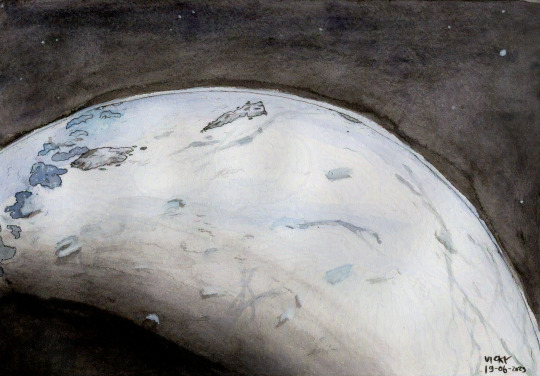
In the Cryogenian, the Earth completely froze over. Twice! Life wasn't much to look at yet, but I enjoyed drawing what our planet might have looked like at the time. The girdle of lakes at the left is the equator, which may have had ice-free patches.
Ediacaran
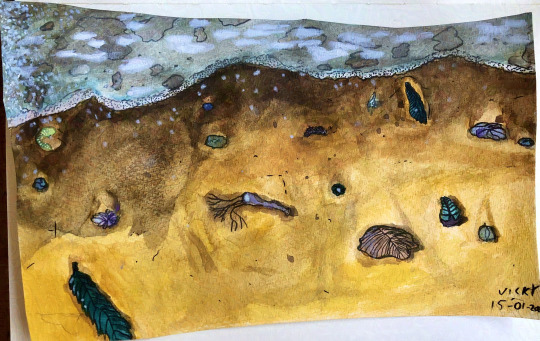
When the ice retreated, animals first began to blossom into their endless forms most beautiful. Ediacaran life was strange and quite unlike the creatures that would come later, but it was nonetheless an incredibly important chapter in life's history. Here we see the Ediacaran weirdos washing up on shore after a storm.
Cambrian

The Cambrian explosion brought much more recognisable creatures. But one thing that's easy to miss is that they were all tiny! All of them? No, Anomalocaris was, with a length of about 40 cm, the dragon of the Cambrian.
Ordovician
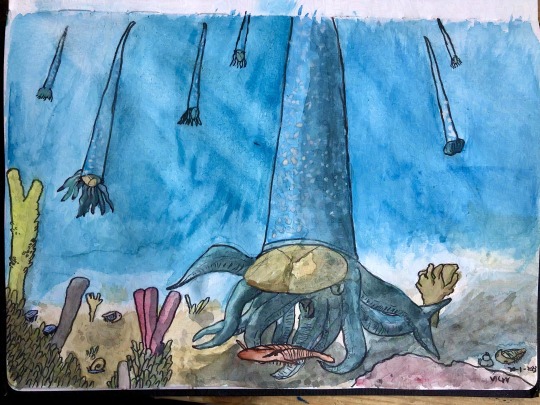
Life continued to diversify in the Ordovician, and among this diversity were the cephalopods. They produced the largest animals yet to exist, the orthocones, who hung vertically in the water column and decended upon their prey like a claw game.
Silurian
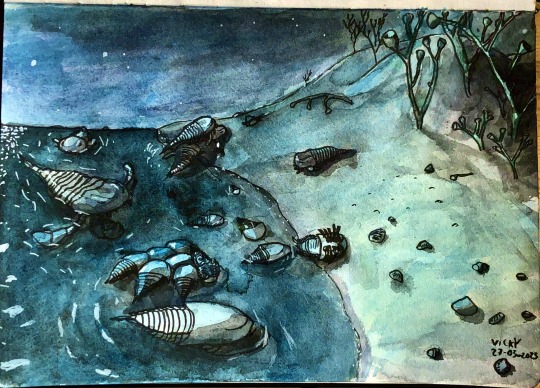
Although fungi and bacteria had already made forays onto the land deep in the past, things began to get busier there in the Silurian. But these horseshoe crabs, and their larger cousins the sea scorpions, have not come to the shore to stay, but to mate and lay eggs. Unfortunately for the horseshoe crabs, they have come to the very same shore.
Devonian
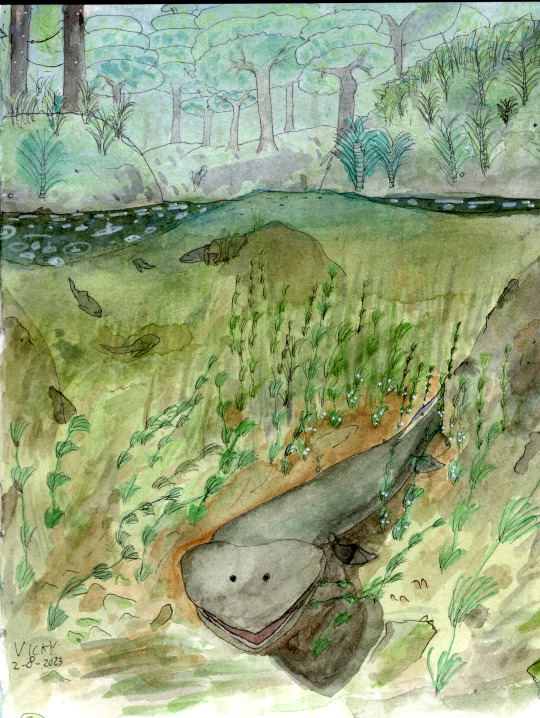
Our own vertebrate ancestors, like Tiktaalik, were pretty late to the party, only taking their first steps on land in the late Devonian. That's no knock against them - there was plenty to do underwater! This Tiktaalik is busy guarding his eggs while his mate is busy hunting, for example. Who has time to step on land?
Carboniferous
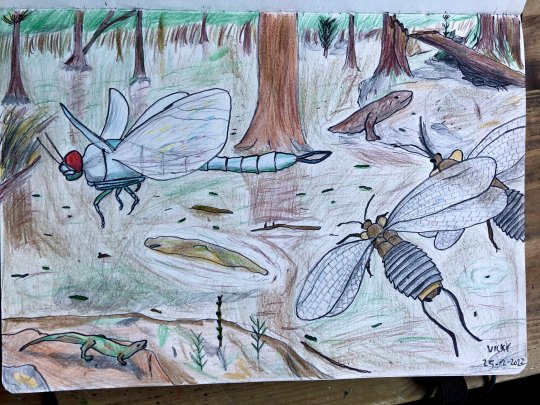
The end of the Carboniferous saw some quite large bugs, like these two Mazothairos chasing off an interloping Meganeura. They're representatives of a pretty interesting group of basal insects called the Palaeodictyoptera, who have a set of weird little extra wings on their thorax.
Permian
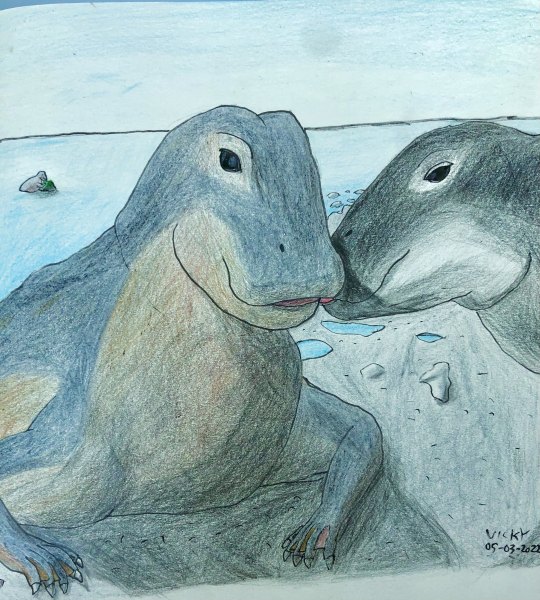
Among the many fantastic creatures of the Permian were our own cousins, the synapsids, like these lovey-dovey Moschops. As you can see, this picture and the previous one are done in coloured pencils instead of watercolour, because they're the oldest images I'm including in this post. I only very rarely used watercolours before this year. I think it means I should do some more Permian art, it's such a cool and underexposed period.
Triassic
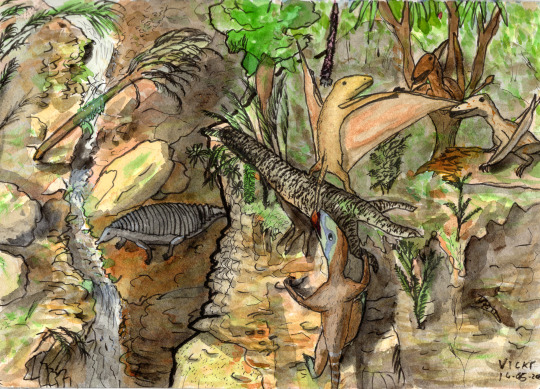
One mass extinction later, the archosaurs are diversifying all over Triassic Pangaea. Here we have the three main groups of them: Paratypothorax, a pseudosuchian in the background; Peteinosaurus, a pterosaur on top of the cliff; and Procompsognathus, a dinosaur climbing the cliff.
Jurassic

I had three different option for Jurassic paleoart to showcase, so I picked the most experimental one. These backlit insects are not butterflies, but kalligrammatids, a group of large-winged neuroptera, some of which even mimicked maniraptoran dinosaurs like this iridescent Caihong with their patterns.
Cretaceous
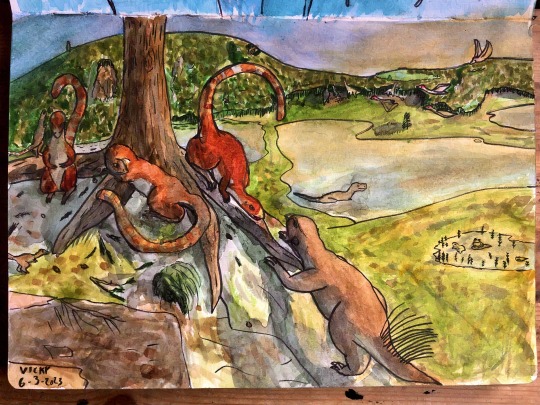
The Cretaceous featured some of life's most gorgeous crescendos of diversity, like the Yixian formation, where a Psitaccosaurus wants to visit the favourite tree of a group of Sinosauropteryxes, who are having none of it. This is still one of my favourite pieces I've ever drawn.
Paleogene
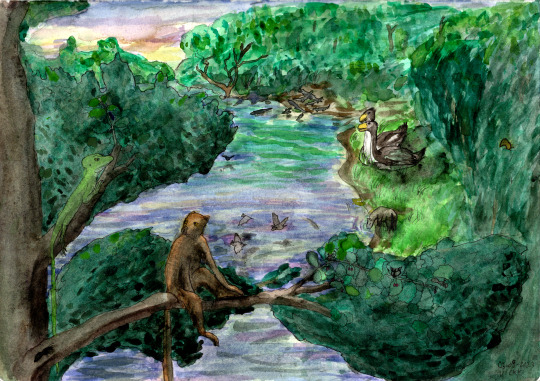
The Paleogene featured some of the highest global temperatures of all time, leading to tropical climates all over the planet, including at this lake in what will one day be Messel, Germany. Darwinius, a close cousin to our own ancestors, is having a staredown with the lizard Geiseltaliellus.
Neogene

The world turned colder and dryer in the Neogene, leading to the spread of large grasslands, like these South American ones. Phorusracos, a large terror bird, has caught a Thoatherium on the edge of the forest they both live in. South America was an isolated continent for the duration of the Neogene, leading to a quite unique fauna.
Quaternary

The Quaternary, our current period, is marked by the cycle of ice ages regularly freezing the northern hemisphere. But even during the ice ages, spring would come to the mammoth steppes, and these steppe mammoths are happy to celebrate its coming with a bath in the river.
#paleoart#my art#palaeoblr#timeline#no i am not gonna tag everything in it#the pictures should all work as links to the individual posts of these pieces#cw: animal death#cw: bugs#cw: parasites#cw: blood
309 notes
·
View notes
Text

The Choir
(Non canon)
#artwork#digital art#art#mouserrouser#monster#dinosaur#bones#paleontology#paleoart#cretaceous period#dino#monster art#maysozoic#fantasy#creature art#butterfly#kalligrammatid#prehistoric animals#prehistoric butterfly#insect#magic?#eldritch#eldritch horror#lacewing#monster design#concept art
5 notes
·
View notes
Note
Paleoinsects are too cool to me.
Like, kalligrammatid lacewings? Butterflies 1.0? Insects that had all the diagnostic features of butterflies before butterflies ever butterflew? Right down to colorful wing scales, probosces, and eyespots?

FUCK
You said that insects originally had six wings?
Yeah the Palaeodictyopterawere once dominant flying insects around the world and they had a “prothoracic” segment with its own set of “winglets,” arguably not true wings because of some anatomical differences but they seemed to be functional. So small though that I don’t think we know what they were for, exactly.

Fossils show a lot of them had butterfly-like colors on all wings/winglets.
640 notes
·
View notes
Text

Ostromia with smol friends; pair of kalligrammatid, stem-gecko Eichstaettisaurus, and possible grylloblattid.
8 notes
·
View notes
Text

Lacewings.
#artwork#digital art#art#mouserrouser#monster#dinosaur#bones#paleontology#paleoart#cretaceous period#dino#monster art#maysozoic#fantasy#creature art#butterfly#kalligrammatid#prehistoric animals#prehistoric butterfly#insect#magic?#eldritch#eldritch horror#lacewing
5 notes
·
View notes
Note
Dinosaurs could have could have enjoyed the presence of kalligrammatids, though, which weren’t butterflies but looked so, so much like them! Reading about them in Smithsonian made me happy and sad all at once, because there are so MANY wonderful things from the past world that we will never know about.
https://www.smithsonianmag.com/smart-news/jurassic-era-insect-looks-just-modern-butterflies-180958040/

Hey bunjy question, whats the earliest evidence we have of butterflies? And do you have a fave butterfly?
butterflies are actually a very recent development, and didn’t show up until AFTER the dinosaurs died out, about 50ish million years ago!
this actually makes a lot of sense if you think about it, because that’s also when flowering plants first showed up on the scene. (that’s right, dinosaurs never got to experience flowers and that’s AWFUL)
and my favorite butterfly is the Monarch, thanks for asking!

856 notes
·
View notes
Text
My art in 2023
January
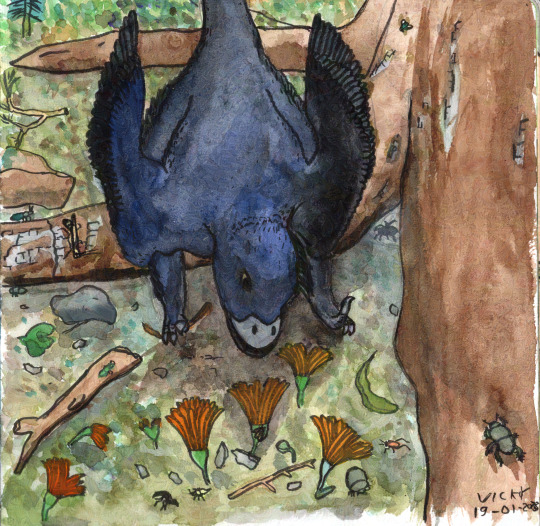
Microraptor and the Flowers. I started this year out making paleoart watercolours and never really stopped. This one is about a Microraptor investigating the first flowers she's ever seen. The flowers are Lingyuananthus, a lovely little fossil flower described in an even lovelier paper that was not behind a paywall for once.
February

Orthocones Descend. Having moved into a new apartment and made a timeline covering the walls, the paleozoic looked awfully empty, so I made a big effort to expand my horizons and do art showing creatures I'd never drawn before. Showing orthocones descending vertically on their prey made for a fun composition too.
March

Sinosauropteryx does not want to share its tree. I still can barely believe we know the colours of both Sinosauropteryx and Psittacosaurus. Dinosaur colours always felt like something we'd never figure out without literal actual time travel before we figured them out.
April
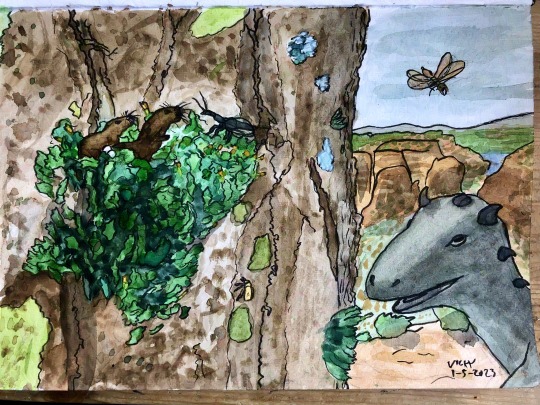
Hadrocodium's mossy home. I got the idea for one of the tiniest mammals of all time making its home in some moss on a tree while hiking in Switzerland and coming across some truly impressive moss beards.
May
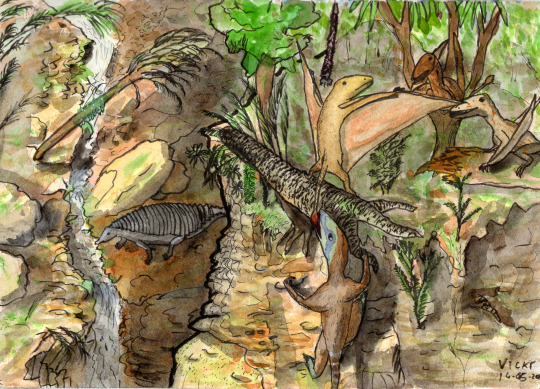
Procompsognathus's cliff climb. Although the foreground cliff itself and the contrast between foreground and background didn't come out quite as well as I'd hoped, I still really like this art featuring the three main branches of archosaur (dinosaur, pterosaur, and pseudosuchian).
June

Anomalocaris, Dragon of the Cambrian. The realisation that most Cambrian creatures were tiny gave me the idea of a whole bunch of them hiding from a 40 cm long Anomalocaris while in positions reminiscent of a D&D party facing off against a dragon.
July
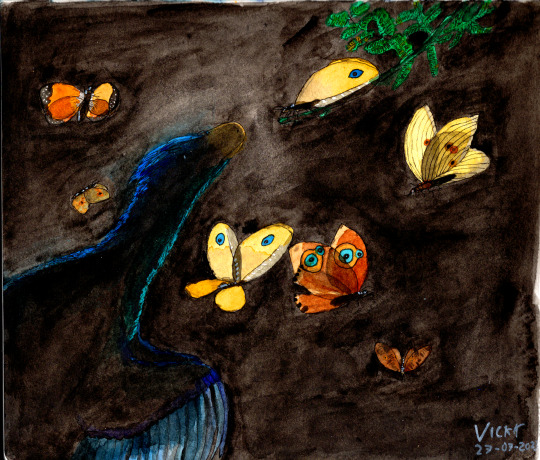
Caihong and the Kalligrammatids. Kalligrammatids were neuropterans that superficially resembled large butterflies, but unlike them their wings were transparent! I combined them with the gorgeous iridescence of Caihong and backlighting for a fun experiment.
August

Spring on the mammoth steppe. When the time came to do some art set in the Quaternary, I decided to depict a real life location and how it would have changed in the past few hundred thousand years. This spot is just west of Baden-Baden (which is in the glacier valley to the upper left), on the edge of the Schwartzwald. I also enjoyed depicting an ice age spring. It wasn't always snow and ice.
September
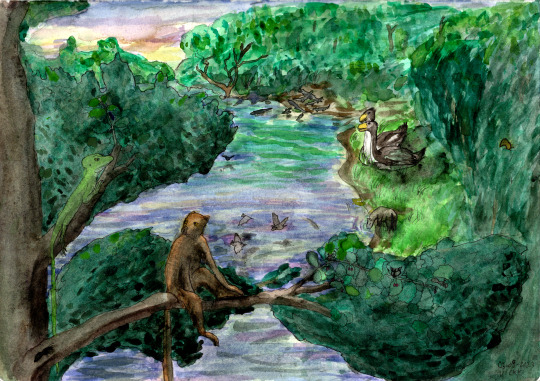
Darwinius and Geiseltaliellus's stare-off. The Paleogene was the last remaining Phanerozoic period I hadn't done any art of, so I drew this little scene in the Messel Pit formation.
October

Inostrancevia family at sunrise. I hadn't drawn Permian synapsids in a while at this point so they were overdue for a paleoart. I also felt like going absolute ham with my reds. The sunrise and Permian volcanism made for a convenient excuse but really, this is just for me.
November
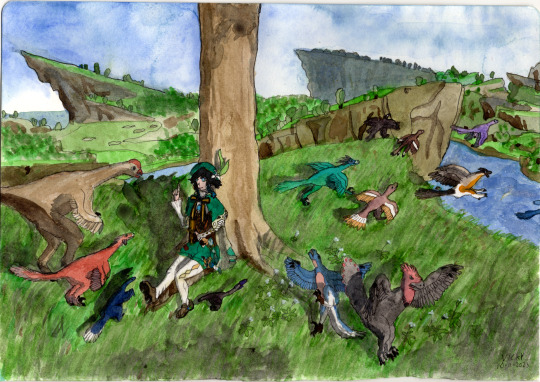
Wind, Courage, and Wings. This one's a birthday gift for my friend, depicting a lovely fable in Genshin Impact about how the wind god Barbatos taught the first birds to fly.
December

The Zanclean Flood. 6 million years ago, the movement of the continents cut the Mediterranean off from the oceans. Since more water evaporates from the Mediterranean than it receives from rivers, this resulted in the sea drying up and becoming an incredibly deep, dry, salty lowland. Until 5.3 million years ago, when the Strait of Gibraltar formed and the entire sea was refilled in a massive flood. This depicts the early days of said flood seen from the tip of the Rock of Gibraltar.
If you've enjoyed my art this year, consider leaving me a tip! Or have a look at last year's art too.
#paleoart#my art#palaeoblr#2023#my art in 2023#watercolour#definitely not gonna tag every creature appearing in these#cw: bugs
52 notes
·
View notes